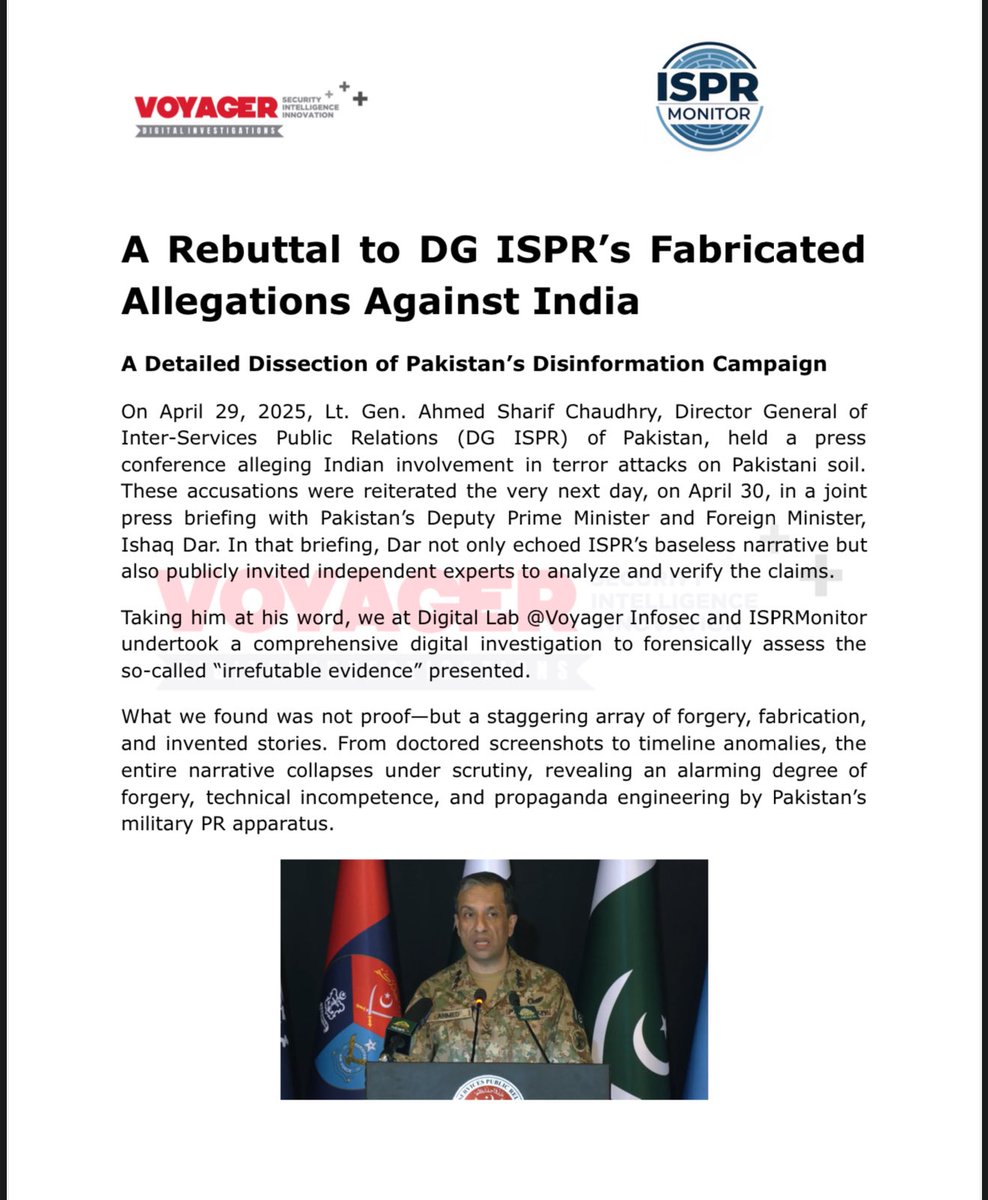SOURCE: AFI

A comprehensive digital investigation conducted by Digital Lab Voyager Infosec and ISPRMonitor has debunked Pakistan’s claims of Indian involvement in terrorist attacks, revealing a web of fabricated evidence presented by Pakistan’s Inter-Services Public Relations (ISPR). Published on May 4, 2025, by The Economic Times, the investigation exposes doctored screenshots, timeline inconsistencies, and manipulated financial trails, indicating a deliberate effort by Pakistan to engineer a false narrative blaming India for attacks, including the April 22, 2025, Pahalgam terror attack in Jammu & Kashmir.
This revelation, amid escalating tensions between the two nations, underscores Pakistan’s disinformation tactics and strengthens India’s position as a victim of cross-border terrorism.
The investigation follows Pakistan’s claims, amplified by ISPR and Foreign Minister Ishaq Dar, that India orchestrated terror attacks within Pakistan, including alleged operations in Balochistan. These accusations emerged after the April 22, 2025, terrorist attack in Pahalgam, Kashmir, which killed 26 tourists and was attributed by India to Pakistan-backed militants. Pakistan’s military, through a press conference by ISPR, presented what it called “irrefutable evidence” of Indian involvement, including screenshots of communications, financial transactions, and alleged confessions. The claims were part of a broader narrative to deflect blame for the Pahalgam attack and portray Pakistan as a victim of Indian aggression.
However, the digital investigation by Voyager Infosec and ISPRMonitor, a platform tracking Pakistan’s military propaganda, revealed these claims as baseless.
Key Findings of the Investigation
The investigation meticulously analyzed Pakistan’s evidence, uncovering multiple discrepancies that dismantled ISPR’s narrative:
- Doctored Screenshots: ISPR presented screenshots of alleged communications between Indian operatives and terrorists. The investigation found these images were manipulated, with inconsistencies in fonts, timestamps, and metadata suggesting digital forgery. For instance, timestamps did not align with the claimed events, and some images showed signs of Photoshop editing, such as irregular pixel patterns.
- Timeline Inconsistencies: Pakistan’s narrative included a timeline linking Indian agents to specific attacks. The investigation revealed that key events cited by ISPR predated the alleged communications, rendering the timeline implausible. For example, financial transactions supposedly funding attacks were dated after the incidents they were meant to support.
- Manipulated Financial Trails: ISPR claimed Indian entities transferred funds to terrorists via international accounts. The investigation traced these transactions to fictitious accounts, with some linked to shell companies that did not exist at the time of the alleged transfers. Blockchain analysis further confirmed the absence of any credible financial trail.
- Use of Chinese Drones: The investigation uncovered that ISPR’s evidence included footage purportedly showing Indian drones orchestrating attacks. Analysis revealed the drones were Chinese-manufactured models commonly used by Pakistan’s military, not India, suggesting a deliberate attempt to mislead.
- Fabricated Confessions: Alleged confessions by captured operatives were found to be scripted, with linguistic analysis indicating they were written by non-native speakers, likely ISPR operatives, rather than Indian agents. The confessions lacked verifiable details and contained factual errors about Indian military operations.
The fabricated allegations come amid heightened India-Pakistan tensions following the Pahalgam attack, which prompted India to impose a complete ban on Pakistani imports and bar port access, citing national security. The attack, widely blamed on Pakistan-backed groups like Lashkar-e-Taiba, led to India scrapping the 2021 LoC ceasefire, with Pakistani troops violating the ceasefire for 10 consecutive days by May 4, 2025.
Pakistan’s disinformation campaign aligns with its historical strategy of deflecting blame for terrorism. The investigation’s findings echo previous instances, such as Pakistan’s debunked claim of shooting down a Rafale jet near the LoC or its April 2025 assertion that J-10CE jets jammed Indian Rafale radars, which was mocked due to the Rafale’s superior SPECTRA electronic warfare suite. The Pahalgam attack, condemned internationally, has further isolated Pakistan, with India leveraging digital forensics to counter ISPR’s narrative.
India’s response to Pakistan’s allegations has been multifaceted. Diplomatically, India has dismissed the claims as “false and malicious,” with the Ministry of External Affairs citing the investigation’s findings. Militarily, India has reinforced its LoC defenses, with the Border Security Force (BSF) adding two field headquarters and 16 battalions to counter Pakistan and Bangladesh border threats. Economically, the import ban and port restrictions aim to choke Pakistan’s trade, which relies on indirect routes through Dubai and Singapore, costing Pakistan an estimated $1–2 billion annually.
NOTE: AFI is a proud outsourced content creator partner of IDRW.ORG. All content created by AFI is the sole property of AFI and is protected by copyright. AFI takes copyright infringement seriously and will pursue all legal options available to protect its content.